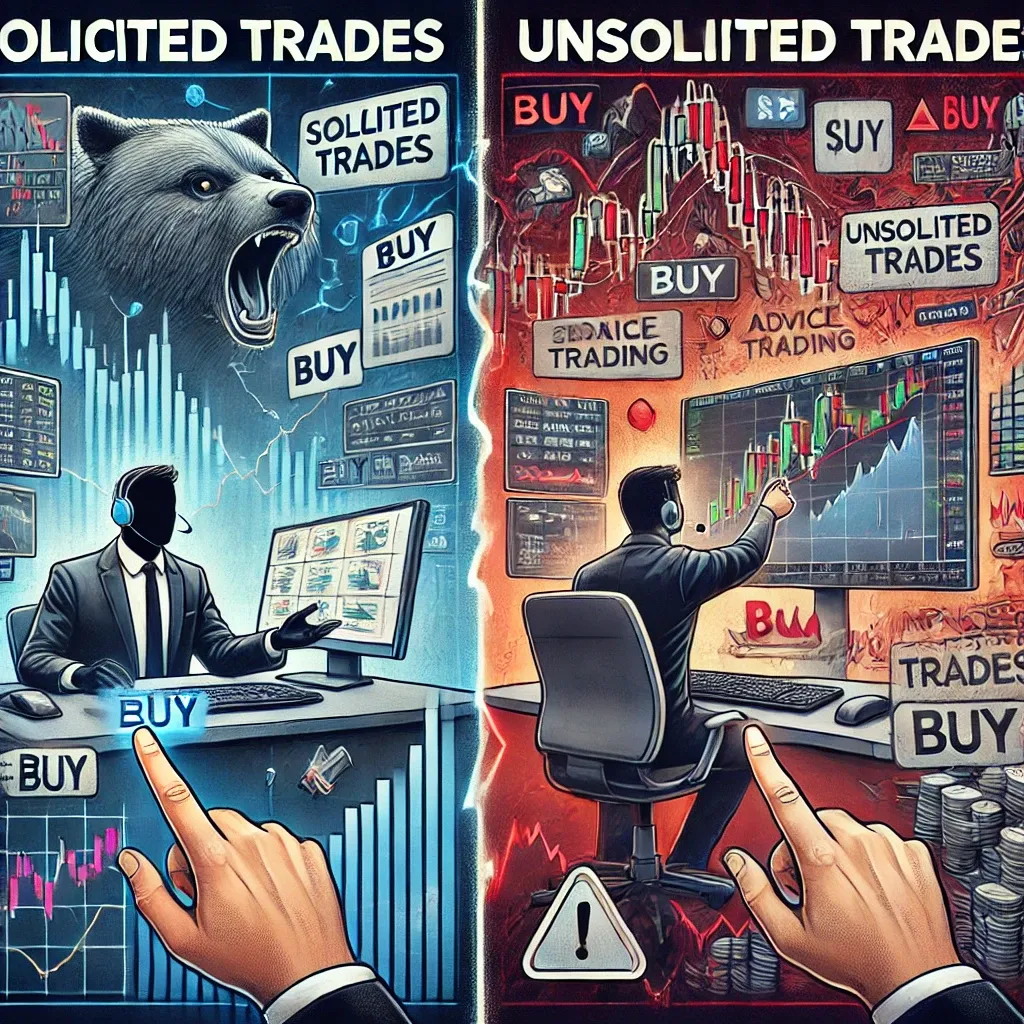Solicited vs Unsolicited Trades: How They Compare

Whether you're new to trading or an experienced investor, understanding the nuances of solicited vs unsolicited trades can significantly impact your trading journey. The distinction between these two types of trades plays a crucial role in how decisions are made and executed in the financial markets. A solicited trade involves recommendations from a financial advisor or broker, while an unsolicited trade is initiated by the client without any prompt or recommendation. The difference, although subtle, can influence not only the outcomes but also the responsibilities and legal implications tied to these trades. Understanding this terminology empowers traders to navigate financial markets more effectively and with increased confidence. In this blog, we will delve deeper into these concepts, offering insights that could help traders make informed decisions and potentially enhance their profitability. Speaking of achieving trading success, considering a funded account can be a gamechanger. Check out various types of accounts available for traders to explore more opportunities. As you learn more about this essential distinction, you'll understand why it matters for anyone engaging with the complexity of financial markets.
What Are Solicited vs Unsolicited Trades?
In the context of trading, the notion of solicited vs unsolicited trades forms a fundamental base of understanding market dynamics and client-broker interactions.
What is a Solicited Trade?
A solicited trade is initiated by the recommendation or suggestion of a broker or financial advisor. This means that the broker has actively provided advice or encouragement to initiate or alter a position in the market. Brokers are supposed to act in their clients’ best interest, so their advice typically stems from analysis or insights aimed at Capital growth or risk management. However, it’s crucial to note that rules around broker recommendations can vary greatly. By following a broker's recommendation, traders can leverage the expertise and insights of a professional. Think of it as having navigational guidance when exploring treacherous roads; the broker provides a map, but the journey is still in the trader’s hands.
What is an Unsolicited Trade?
In contrast, an unsolicited trade is led purely by the client’s initiative. It is conducted without the prompt or recommendation of a broker, meaning that the client independently decides to execute the trade. Thus, understanding the unsolicited trade meaning is crucial for those who prefer total autonomy over their trading decisions. Such trades can be seen as a double-edged sword; they embody a higher level of independence and accountability, yet require extensive personal research and vigilance about market conditions. If you've ever pondered what does unsolicited mean in financial jargon, it boils down to you being the sole captain of your trading ship—steering without external prompts.

Real-Life Examples of Solicited and Unsolicited Trades
In the world of trading, understanding the difference between solicited and unsolicited trades is essential for both compliance and risk awareness. A solicited trade occurs when a broker or advisor recommends a specific trade to a client, often supported by documentation or a verbal pitch. For example, if a financial advisor suggests buying shares of Apple based on recent earnings and the client agrees, that’s a solicited trade. On the other hand, an unsolicited trade is initiated entirely by the client without any prompting from the advisor. A common real-life scenario would be a retail investor logging into their brokerage account and independently placing an order to purchase Tesla stock after reading about its performance online. These distinctions matter because solicited trades carry different regulatory responsibilities, and brokers must ensure that their recommendations are suitable for the client's investment profile.
A Typical Solicited Trade
Imagine an investor planning to buy stocks but hesitant due to market volatility. The broker suggests purchasing stocks in a tech firm based on projected earnings and growth trends. The investor follows this advised path, leveraging the broker's research and market insight. This transaction represents a solicited trade, relying on brokerage influence.
A Typical Unsolicited Trade
In a different scenario, a seasoned investor may decide to purchase or sell stocks based solely on personal analysis of quarterly financial reports and market trends. Here, the investor initiates a trade without external advice, embodying the concept of unsolicited trading.
Solicited vs Unsolicited Orders
Beyond individual trades, understanding the distinctions between solicited and unsolicited orders is also critical.
What is a Solicited Order?
A solicited order occurs when a client places an order based on a broker's direct recommendation or advice. A vivid example includes receiving targeted order suggestions as part of financial strategies broker services offer, aligning with a broader market view.
What is an Unsolicited Order?
Conversely, an unsolicited order epitomizes the trader’s action without any external prodding, such as submitting a buy or sell request after independent exploration or acting on instinctive market anticipation. Unsolicited activities oftentimes reflect a mature, confident stance towards market interactions. This journey can be greatly facilitated by accessing preferred platforms tailored for traders — the preferred platforms resource gives you a head start in finding tools that suit your trading style.
Why Does the Solicited vs Unsolicited Distinction Matter?
Unraveling the implications of solicited vs unsolicited trade distinctions is imperative, especially for regulatory, compliance, and dispute resolution.
Regulatory and Compliance Issues
Regulations governing solicited and unsolicited trades are diverse and complex. Financial authorities often ensure brokers disclose whether a trade was solicited or unsolicited, as it affects the level of responsibility and risk mitigation they owe their clients. For brokers, failing to clarify trade types could lead to regulatory repercussions. Firms often detail their policies and responsibilities extensively on their website for clarity and compliance. Furthermore, understanding whether an order is solicited can affect liability and compliance within various legal frameworks, protecting both parties in trading transactions.
Disputes and Complaint Handling
Grievances and complaints in trading often arise from misunderstandings over whether a trade was solicited or unsolicited. Misinterpretations of advice as recommendations or orders can lead to disputes regarding accountability for losses or gains. Establishing clarity in communication is vital for successful trading types. Thus, familiarizing oneself with the boundaries delineating these terms is not only beneficial but often essential for preempting issues and fostering positive trader-broker relationships.
Final Words on Unsolicited vs Solicited Trades
The nuanced distinction between solicited and unsolicited trades embodies more than just a linguistic difference—it's central to how investors and traders approach the market. Whether leaning on the expertise of professionals through solicited trades or embracing independent decision-making via unsolicited trades, each choice involves unique implications and responsibilities. As the world of trading continues to evolve, having a foundational understanding of terms like solicited vs unsolicited can empower traders to make informed, confident decisions. This distinction feeds into not only daily trading activities but also long-term strategic planning. When considering potential trading pathways, options such as becoming part of a funded futures network can also open doors to new possibilities and enhance your financial literacy. By internalizing these concepts, traders can shed light on their style and strategy, paving a clear path to proficiency and potential profitability.



